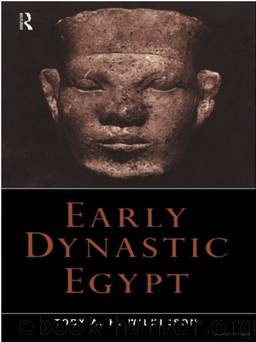Early Dynastic Egypt by Toby A. H. Wilkinson

Author:Toby A. H. Wilkinson [Wilkinson, Toby A. H.]
Language: eng
Format: epub
Tags: Social Science, Archaeology
ISBN: 9780415260114
Google: ih2EAgAAQBAJ
Amazon: 0415260116
Publisher: Routledge
Published: 2001-06-13T16:00:00+00:00
nswt-bỉty names
After the title nswt-bỉty came a name which may also have been the king’s birth name (S.Schott 1956:76). It was certainly the name by which many kings were known in later annals and king lists. The nswt-bỉty title was often paired with the element nbty, after the introduction of the latter in the reign of Semerkhet. Peribsen was the first king to separate the two elements and use the nswt-bỉty title alone once more (S.Schott 1956:61), on a sealing from Abydos (Petrie 1901: pl. XXII.190).
Den’s nswt-bỉty name, zmtỉ (S.Schott 1956:60), appears on many contemporary inscriptions, especially the stone vessels found beneath the Step Pyramid. The name was also used on royal seals, frequently without reference to the king’s Horus name. It must, therefore, have had a significance of its own. It means ‘the two deserts’, referring to the eastern and western deserts which guarded the Nile valley on each side. It reinforces the message of the nswt-bỉty title: that the king’s rule extends over the whole of Egypt, east and west as well as north and south. Given the evidence that Den probably conducted a military campaign against the nomadic tribespeople of the eastern desert, his nswt-bỉty name may have had added resonance, proclaiming his intention to subdue Egypt’s desert borderlands and bring them under his yoke. An alternative reading of the name is h 3stỉ, translated as ‘the foreigner’ or ‘the Sinaitic’ (Godron 1990:21). It has been suggested that
Den adopted this secondary name following a military success against the inhabitants of the Sinai, recorded on the ivory label from Abydos (Godron 1990:180).
The nswt-bỉty-nbty name of Den’s successor, the Horus Anedjib, is curious and quite impenetrable: mr-p-bỉ3. For many years, the nswt-bỉty-nbty name of Semerkhet likewise defied interpretation; but it has now been shown to read ỉrỉ-n r, ‘guardian of the god’. If the nbty element is interpreted as forming part of the name, rather than another title, then the name should read ỉrỉ-nbty, ‘guardian of the Two Ladies’ (Quirke 1990:23). The name expresses the close relationship between the king and the divine sphere. It also conveys something of the tension inherent in the ideology of divine kingship: the king is separate from the rest of humanity, the interlocutor between people and gods, indeed the gods’ representative on earth; but he is still not quite one of the gods, possessing only ‘limited divinity’ (Quirke 1990:11). It is the royal ka, the divine essence incarnate in the king, which passes unchanged from generation to generation; the king himself cannot escape death. Finally, the nswt-bỉty-nbty name of Hetepsekhemwy (htp) is merely an abbreviation of his Horus name.
Download
This site does not store any files on its server. We only index and link to content provided by other sites. Please contact the content providers to delete copyright contents if any and email us, we'll remove relevant links or contents immediately.
| Africa | Americas |
| Arctic & Antarctica | Asia |
| Australia & Oceania | Europe |
| Middle East | Russia |
| United States | World |
| Ancient Civilizations | Military |
| Historical Study & Educational Resources |
Empire of the Sikhs by Patwant Singh(22769)
The Wind in My Hair by Masih Alinejad(4847)
The Templars by Dan Jones(4560)
Rise and Kill First by Ronen Bergman(4547)
The Rape of Nanking by Iris Chang(4024)
12 Strong by Doug Stanton(3420)
Blood and Sand by Alex Von Tunzelmann(3060)
The History of Jihad: From Muhammad to ISIS by Spencer Robert(2507)
Babylon's Ark by Lawrence Anthony(2433)
The Turkish Psychedelic Explosion by Daniel Spicer(2246)
No Room for Small Dreams by Shimon Peres(2239)
Gideon's Spies: The Secret History of the Mossad by Gordon Thomas(2236)
Inside the Middle East by Avi Melamed(2233)
Arabs by Eugene Rogan(2196)
The First Muslim The Story of Muhammad by Lesley Hazleton(2155)
Bus on Jaffa Road by Mike Kelly(2036)
Come, Tell Me How You Live by Mallowan Agatha Christie(2029)
Kabul 1841-42: Battle Story by Edmund Yorke(1926)
1453 by Roger Crowley(1881)
